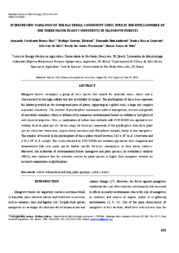Interspecific variation of the bacterial community structure in the Phyllosphere of the three major plant components of mangrove forests.
Interspecific variation of the bacterial community structure in the Phyllosphere of the three major plant components of mangrove forests.
Autoria: DIAS, A. C. F.; TAKETANI, R. G.; ANDREOTE, F. D.; LUVIZOTTO, D. M.; SILVA, J. L. da; NASCIMENTO, R. dos S.; MELO, I. S. de
Resumo: ABSTRACT: Mangrove forests encompass a group of trees species that inhabit the intertidal zones, where soil is characterized by the high salinity and low availability of oxygen. The phyllosphere of these trees represent the habitat provided on the aboveground parts of plants, supporting in a global scale, a large and complex microbial community. The structure of phyllosphere communities reflects immigration, survival and growth of microbial colonizers, which is influenced by numerous environmental factors in addition to leaf physical and chemical properties. Here, a combination of culture-base methods with PCR-DGGE was applied to test whether local or plant specific factors shape the bacterial community of the phyllosphere from three plant species (Avicenia shaueriana, Laguncularia racemosa and Rhizophora mangle), found in two mangroves. The number of bacteria in the phyllosphere of these plants varied between 3.62 x 104 in A. schaeriana and 6.26 x 103 in R. mangle. The results obtained by PCR-DGGE and isolation approaches were congruent and demonstrated that each plant species harbor specific bacterial communities in their leaves surfaces. Moreover, the ordination of environmental factors (mangrove and plant species), by redundancy analysis (RDA), also indicated that the selection exerted by plant species is higher than mangrove location on bacterial communities at phyllosphere.
Ano de publicação: 2012
Tipo de publicação: Artigo de periódico
Unidade: Embrapa Meio Ambiente
Palavras-chave: Bactéria, Culture-independent profiling, Mangrove forests, Mangue, Phyllosphere, Plant genotype, Planta, Surface leaves
Observações
1 - Por padrão são exibidas publicações dos últimos 20 anos. Para encontrar publicações mais antigas, configure o filtro ano de publicação, colocando o ano a partir do qual você deseja encontrar publicações. O filtro está na coluna da esquerda na busca acima.
2 - Para ler algumas publicações da Embrapa (apenas as que estão em formato ePub), é necessário ter, no celular ou computador, um desses softwares gratuitos. Sistemas Android: Google Play Livros; IOS: iBooks; Windows e Linux: software Calibre.
Acesse outras publicações
Acesse a Base de Dados da Pesquisa Agropecuária (BDPA) para consultar o acervo completo das bibliotecas da Embrapa.

